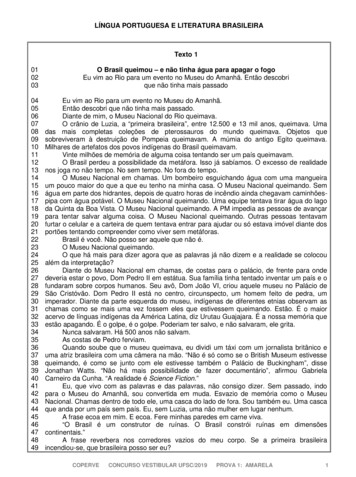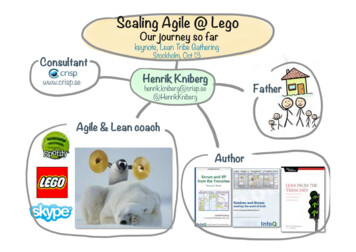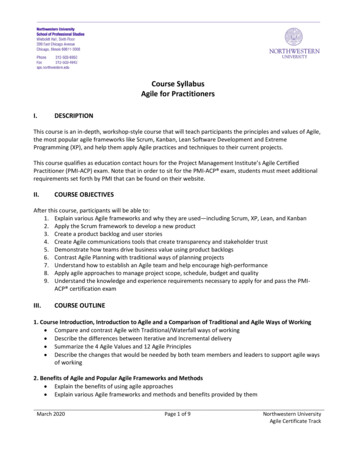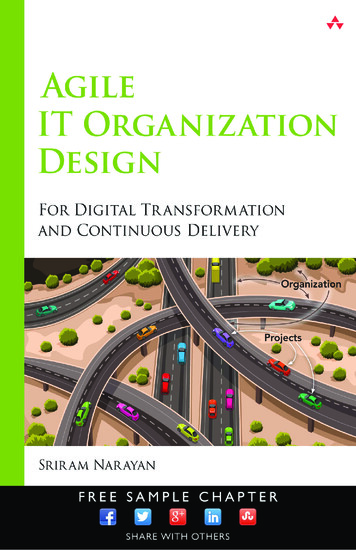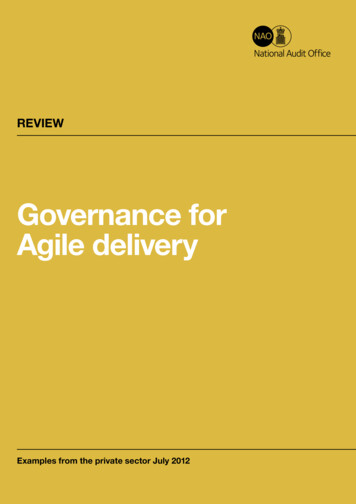
Transcription
REVIEWGovernance forAgile deliveryExamples from the private sector July 2012
2 Governance for Agile deliveryOur vision is to help the nationspend wisely.We apply the unique perspectiveof public audit to help Parliamentand government drive lastingimprovement in public services.The National Audit Office scrutinisespublic spending for Parliamentand is independent of government.The Comptroller and Auditor General(C&AG), Amyas Morse, is an Officer ofthe House of Commons and leads theNAO, which employs some 860 staff.The C&AG certfies the accounts ofall government departments andmany other public sector bodies.He has statutory authority to examineand report to Parliament on whetherdepartments and the bodies they fundhave used their resources efficiently,effectively, and with economy.Our studies evaluate the value formoney of public spending, nationallyand locally. Our recommendationsand reports on good practice helpgovernment improve public services,and our work led to audited savings ofmore than 1 billion in 2011.
ContentsPart OneIntroduction 4Part TwoAgile delivery in government 7Part ThreeGovernance of Agile delivery 8Part FourPrivate sector case examples 11Appendix OneMethods 30Appendix TwoKey Agile terms and concepts 31Appendix ThreeNational Audit Office publicationsfocusing on the key components ofgovernment ICT 33The National Audit Office study team consisted of:Jayne Goble, Ebrahim Gora, Paul Grindle, Jonathan Hydeand Alison Terry under the direction of Sally Howes
4Part One Governance for Agile deliveryPart OneIntroduction1.1 The term agile is commonly associated with software development.1 Publications promotingagile development became particularly prevalent from the 1990s but it was not until 2001 thata group of software developers summarised the core philosophy behind agile developmentmethodologies. The Agile Manifesto2 lists 12 principles (Figure 1) and four key values:OOIndividuals and interactions are more important than processes and tools.OOProduce working software in preference to comprehensive documentation.OOInvest time in collaborating instead of negotiating with suppliers.OORespond to change rather than following a predetermined plan.Figure 1Principles behind the Agile Manifesto1Our highest priority is to satisfy the customer through early and continuous delivery of valuable software.2Welcome changing requirements, even late in development. Agile processes harness change for thecustomer’s competitive advantage.3Deliver working software frequently, from a couple of weeks to a couple of months, with a preference tothe shorter timescale.4Business people and developers must work together daily throughout the project.5Build projects around motivated individuals. Give them the environment and support they need, and trustthem to get the job done.6The most efficient and effective method of conveying information to and within a development team isface-to-face conversation.7Working software is the primary measure of progress.8Agile processes promote sustainable development. The sponsors, developers, and users should be ableto maintain a constant pace indefinitely.9Continuous attention to technical excellence and good design enhances agility.10 Simplicity – the art of maximising the amount of work not done – is essential.11 The best architectures, requirements and designs emerge from self-organising teams.12 At regular intervals, the team reflects on how to become more effective, then tunes and adjusts itsbehaviour accordingly.Source: s and the private sector have run some major engineering projects in an iterative and incrementalway since the late 1950s. For example, the Government of the United States of America’s project for theX-15 hypersonic jet is cited as an important example of how iterative and incremental development could beapplied to deliver a successful outcome.Available at: www.agilemanifesto.org
5Governance for Agile delivery Part One1.2 The Government intends to use agile in information and communications technology (ICT)procurement and delivery to reduce the risk of project failure.3 At a hearing of the Committeeof Public Accounts in May 2011, it became clear that the Government did not consider agilesolely as a method for improving software development. It is also a technique for successfulICT-enabled business change. The then Cabinet Office Permanent Secretary stated that “thereis no such thing as an IT project; there are only business projects that involve IT”. He also saidthat trying “to change the whole system nationally on a single day – the so-called ‘big bang’implementation – is doomed to failure in almost every situation.”41.3 Consequently in this report we use the term ‘Agile’ as an umbrella for a group ofmethodologies that can be used to manage business change projects. The practices in thesemethodologies are different, but in general Agile delivery teams will develop a project:OOOOin an iterative and incremental way. In each short phase 5 a delivery team will build part ofthe system and test it. The delivery team gives priority to areas of high impact or value tothe organisation to reduce the risk that it fails to deliver a usable system. At the end of eachiteration there is a working product of a quality that the business could deploy and thatusers 6 can definitely try. User feedback helps the delivery team to improve the functionalityin the next and subsequent iterations, identify what more needs to be added to the systemand the order of priority; andby responding to change. A delivery team can accommodate valid changes to requirementsor in technology because the system is built up incrementally.1.4 The then Cabinet Office Permanent Secretary also told the Committee of Public Accountsthat “most IT projects fail because of people, not because of technology.”4 Successful Agiledelivery is highly reliant on the right input from people. An Agile delivery team collaboratescontinually with users through face-to-face communication. It meets the needs of users bydelivering working systems early on in the project. The delivery team self-manages, collectivelydeciding the best way to deliver the work and is self-improving. Team members regularly reflecton how they can become more effective and adapt to maintain and increase the quality of theirwork.1.5 This is the first in a series of reports on Agile. Our findings will be of interest to those inpublicly funded bodies who are using or considering Agile delivery. The Institute for Governmenthas stated that effective governance and accountability structures are vital for an Agile approachto work.7 We aim to provide practical support to organisations to meet government policyobjectives to use Agile delivery to improve public services, including making more of them digital.34567Cabinet Office, Government ICT Strategy, March 2011, available at ategy/Available at: t/cmpubacc/c1050-i/c105001.htmA team selects a number of days (typically between five and twenty) to be the length of its iteration and thisremains constant throughout the project.A user is an individual who benefits from a product or service. They may not necessarily purchase theproduct or service.Institute for Government, System Error: Fixing the flaws of government IT, March 2011, available ystem-error
6Part One Governance for Agile delivery1.6 In early 2012, we interviewed private sector technologists and project managers about theirexperience of introducing and using Agile in their organisations. We also drew on the knowledgeof subject matter experts from professional service companies. Using this information we haveidentified some common themes about governance for Agile delivery. The case examples in thisreport illustrate how private sector organisations have developed their governance processes tosupport the successful delivery of Agile projects and programmes. The organisations were notthe subject of National Audit Office audits. We do not conclude on which governance processesshould be used in government.1.7 Appendix One outlines our methods. The key Agile terms and concepts we use in the caseexamples are listed in Appendix Two. Appendix Three shows how this report fits in with otherNational Audit Office publications on government ICT.
7Governance for Agile delivery Part TwoPart TwoAgile delivery in government2.1 The public and private sectors are interested in Agile delivery to help combat the perceivedproblems with traditional methods for ICT-enabled business change projects. These include:OOlow user satisfaction, because people find systems difficult to operate;OOlate delivery of systems and failure to realise the expected benefits;OOhigh costs to make simple system changes; andOOobsolescent systems, because technology changes rapidly.82.2 In March 2011, the Institute for Government advocated the use of Agile methods forgovernment ICT projects because existing ‘best practice’ processes cannot deal with systemicflaws in traditional methods. The Institute for Government said it is difficult for government to lockdown system requirements at the start and manage delivery against a predetermined timetablebecause priorities change rapidly and technological development is unpredictable and non-linear.It did recognise, however, that central government faces particular challenges if it adopts Agilemethods because of the complex and hierarchical structures for governance and accountabilityand the organisational culture.2.3OOOOIn the Government ICT Strategy,9 March 2011, the Cabinet Office stated that:technology would be considered earlier in the policy making process and Agile methodswould be applied to respond to changing requirements and reduce waste and the risk ofproject failure; andorganisations would be prevented from creating large ICT programmes wherever possibleand advised to use smaller projects and Agile methods to deliver the right systems andrealise the benefits faster.2.4 In October 2011, government set out its key objectives for Agile in the Government ICTStrategy – Strategic Implementation Plan.10 It will use Agile delivery:OOOOin half of major ICT-enabled change programmes by April 2013; andto reduce the average delivery time for departmental ICT-enabled change programmesby 20 per cent by 2014.2.5 The Strategic Implementation Plan also contained some details on how Agile delivery wouldbe implemented across central government. The Department for Work and Pensions has leadresponsibility for the implementation of Agile delivery and it will make sure that departments:OOreceive advice and support through an online community;OOhave access to small- and medium-sized enterprises that provide relevant Agile services;OOuse Agile delivery methods on projects when appropriate; andOOmeasure and benchmark the outcomes from those projects.Institute for Government, System Error: Fixing the flaws of government IT, March 2011, available ystem-error9 Cabinet Office, Government ICT Strategy, March 2011, available at ategy/10 HM Government, Government ICT Strategy- Strategic Implementation Plan, October 2011, available strategy-strategic-implementation-plan8
8Part Three Governance for Agile deliveryPart ThreeGovernance of Agile delivery3.1 Governance for ICT is for senior management to gain and give assurance that investmentgenerates value to the business and reduce the risk of bad outcomes.11 The processes seniormanagement uses to do this vary between organisations and this report illustrates how eightcompanies have developed their governance for Agile delivery.3.2 Critics of Agile delivery say that the methods allow teams to work in an unstructuredway, which prevents clear lines of accountability and discourages documentation. A surveyin 2011 showed that the most serious challenges to using Agile delivery is the perception thatmanagement control is lost and the difficulty in changing organisational culture.123.3 Proponents of Agile delivery argue that the methods rely on information on the currentstatus of the project being visible to the whole business, instead of central processes forcommand and control. They also believe that, because the methods are designed to be selfassuring, there is proper governance and accountability built into Agile practices. In particular,control processes are more collaborative and are run continuously by the ICT specialists andthe business owner of the product or service in the project delivery team. For example, generallyaccepted good practice in a small delivery team is for:OOOOthe ICT specialists to review each other’s work during each iteration. Team membersrepeatedly test that the system meets all the pre-agreed criteria for an acceptable productor service; andthe business owner and the users to continually check that ‘expected levels of quality’ arereached and sign off products as complete at the end of each iteration. The ICT specialistsare able to improve the product or service or take corrective action based on this userfeedback and ensure they generate the value forecast in the business case. When the timeor cost of developing a solution to a problem appears to outweigh the benefits, teams asksenior management to decide if the project should be re-scoped, paused or stopped.3.4 The Agile community recognises that multiple layers of governance do not necessarilyimprove the quality of technical solutions, speed up delivery or reduce risk. However, wherean organisation is delivering a programme containing multiple projects or runs its business asusual operations through many Agile teams, some senior managers may need to have additionalcontrol processes. For example, they may commission audits to provide assurance that qualityprocedures exist and are effective, and that resources are being used cost-effectively and for theirintended purpose.11 International Organization for Standardization and International Electrotechnical Commission, ISO/IEC 38500Corporate Governance of Information Technology, June 200812 Version One, State of Agile Development, Sixth Annual Survey, 2011, available at www.versionone.com/state ofagile development survey/11/
9Governance for Agile delivery Part ThreePrinciples for governance3.5 We identified four principles that were frequently mentioned by our interviewees as beingkey to successful governance of Agile delivery:aGovernance should mirror the philosophy of Agile methods – only do a task if itbrings value to the business and does not introduce delays. Governance should belight touch and proactive. It should also focus on what activity is taking place and the valueof the services or products. This is in contrast to traditional methods which check what thedelivery team has done to improve the predictions and estimates in the plan and reduce thevariation between the baseline and forecast profile.bAgile delivery teams should decide on the empirical performance metrics theywill use and self-monitor. The overall aim is to improve the certainty teams have thatthey will deliver a usable product or service of good quality. Agile delivery is founded on thephilosophy that teams should ‘fail fast and learn quickly’. Teams quantify their performanceand use the data to improve. For example they measure tasks completed; rework theyhad to perform; the backlog list and the value of the product or service to the businessat the end of each iteration. Teams display this information visually, updating it frequently.This makes progress transparent to business users and management. If senior managersrequire performance information to oversee projects, they define what the ‘must have’ dataare. Performance reports for senior management become a task in each iteration and anoutput of the delivery team.cSenior management, external assessors, business users and the ICT teamshould be partners in quality, and this collaborative approach is an essentialchange in mindset. Once senior management has agreed the outcome for a businesschange project, the corporate goal for the quality of the service is fixed up front. Seniormanagement approves spend by the delivery team at a particular rate over a set periodof time to achieve that outcome. The business owner and delivery team defines what‘quality’ tests they will use and what results are acceptable at the outset of each iteration– the definition of ‘done’. Regular user feedback identifies whether the product or serviceis providing the expected business value at each stage. External assessors are notgatekeepers; rather they are an integral part of the team. The iterative approach ensurescontinual reviews and feedback on progress, so external assessors are not just involved atcritical points as defined in a traditional project life cycle.
10Part Three Governance for Agile deliverydExternal assessment or reviews of Agile delivery should focus on the teams’behaviours and not just processes and documentation. Assessors are more effectivein providing critical challenge if they have high-end skills, including technical and Agiledelivery experience. In addition, they provide better value if they continually review how theteam is performing, using observation as their main method of evidence collection. Key linesof enquiry for assessors include:OOOOOOOOOOOOOOthe skills and experience of the team;the team dynamics – frequency and nature of communication inside and outside ofthe delivery team, and the level of input to the delivery team from the business;the organisational culture – the level of commitment and openness;the timing and nature of quality control by the delivery team – the testing andrelease framework;the order in which the team tackled the tasks – prioritisation of actions anddeliverables, the amount of actions in the backlog list;the way the team changes its activity in response to the results achieved in eachiteration; andthe value of outputs to the business.
11Governance for Agile delivery Part FourPart FourPrivate sector case examples4.1 In this part we illustrate how governance for Agile delivery is set up in seven private sectorcompanies from a variety of business sectors. The companies have either won an award for Agiledelivery or are well-known as users of Agile methods:OOBritish Airways plc (page 11).OOBT plc (page 13).OOInnocent Drinks (page 17).OOIBM United Kingdom Limited (page 20).OOA large UK manufacturing organisation (page 23).OOSimply Business (page 25).OOVodafone Group plc (page 27).4.2 While the examples of governance we give are specific to a company’s business, theyillustrate practices that can be applied more widely. The descriptions of the features of thecompanies’ governance processes in the case examples are not exhaustive.British Airways plc4.3 British Airways plc and its subsidiaries operate international and domestic scheduledair services for passengers, freight and mail. They employ more than 36,000 people acrossthe world, with the majority of positions based in the UK. British Airways serves nearly 250destinations and revenue exceeds 9 billion per year.Supporting the business through Agile delivery4.4 In 2006, after a number of initiatives that increased the frequency of ICT projects beingdelivered, in time and to budget, British Airways staff still said that systems were not meeting theirexpectations. In particular, products and services were not getting to market quickly enough.In response the IT Department introduced Agile methods to some of its software developmentprojects. The business units liked the idea that the solution could evolve as their requirementsbecame more certain and they could stop the project at any point and still have a usable productor service.4.5 By 20
4 Part One Governance for Agile delivery Part One Introduction 1.1 The term agile is commonly associated with software development. 1 Publications promoting agile development became particularly prevalent from the 1990s but it was not until 2001 that a group of software developer


